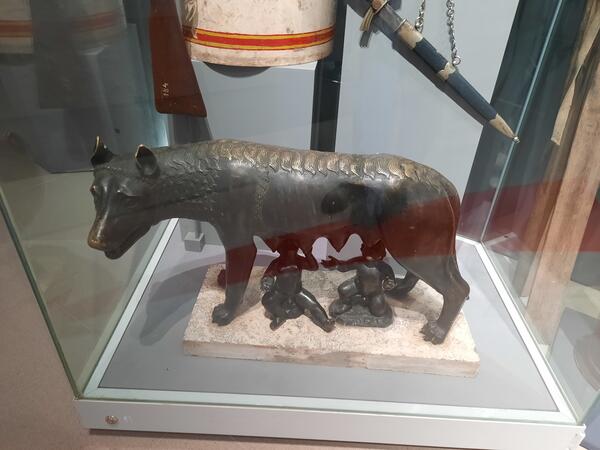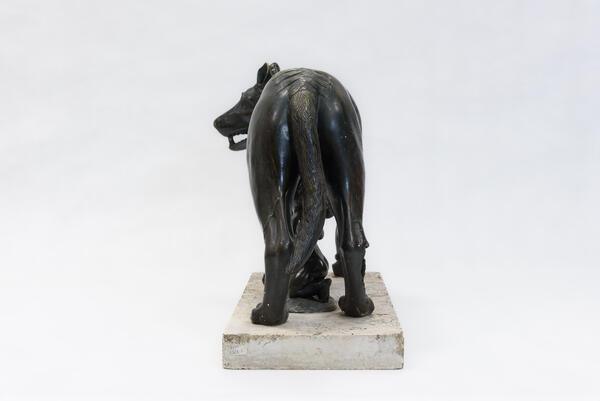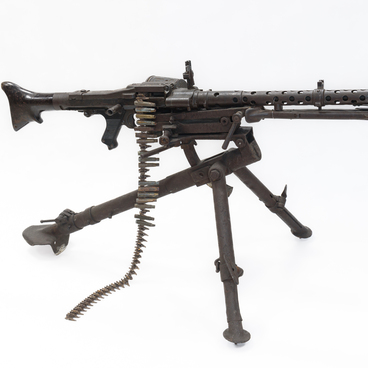“The Capitoline Wolf” is a bronze statue depicting (just under life-sized) a she-wolf suckling two babies — Romulus and Remus, the legendary founders of the city of Rome. The dating is debatable. The image of the she-wolf was for a long time considered a work of ancient Etruscans and, based on its stylistic features, dated to the 5th century BC. The latest dating carried out in the 21st century (which included examining its casting technology, using radiocarbon analysis and other methods) indicates that it was created during the High Middle Ages, that is, the 11th–13th centuries. A similar work located in Rome was mentioned many times in written sources since the Classical Antiquity period; the same legendary scene was depicted on many ancient Roman coins. It is believed that the wolf was a totem of the Sabines and Etruscans, and the statue was moved to Rome as a symbol of their assimilation into the Roman culture.
“The Capitoline Wolf” was first mentioned in Pliny’s “Natural History”. According to him, the statue stood at the Roman Forum near a sacred fig tree. Cicero wrote that the statue was located on the Capitoline Hill and was once struck by lightning; he also mentioned a sculpture of an “infant trying to suck the she-wolf’s udders.” The monk and chronicler Benedict of Soracte (the 10th century) wrote of the institution of a supreme court of justice “in the Lateran Palace, in a place called [illegible], viz. the Mother of the Romans.” Hence, the statue was probably located in the Lateran Palace since the 9th century. There were mentions about trials and executions held “at the She-Wolf” up until 1450. By order of Sixtus IV, the statue was moved to the Palazzo dei Conservatori in 1473.
The bronze figures of Romulus and Remus were cast in the late 15th century; they are attributed to the artist Antonio del Pollaiuolo. An illustration accompanying the work “Marvels of the City of Rome”, popular in the Middle Ages, depicts the Capitoline she-wolf already with the boys.
During the times of Benito Mussolini, the Capitoline Wolf was used as a propaganda symbol, embodying the desire of the fascist regime to revive the Roman Empire. Images of the statue were used on posters and on the emblem of the 1960 Summer Olympics in Rome.
“The Capitoline Wolf” was first mentioned in Pliny’s “Natural History”. According to him, the statue stood at the Roman Forum near a sacred fig tree. Cicero wrote that the statue was located on the Capitoline Hill and was once struck by lightning; he also mentioned a sculpture of an “infant trying to suck the she-wolf’s udders.” The monk and chronicler Benedict of Soracte (the 10th century) wrote of the institution of a supreme court of justice “in the Lateran Palace, in a place called [illegible], viz. the Mother of the Romans.” Hence, the statue was probably located in the Lateran Palace since the 9th century. There were mentions about trials and executions held “at the She-Wolf” up until 1450. By order of Sixtus IV, the statue was moved to the Palazzo dei Conservatori in 1473.
The bronze figures of Romulus and Remus were cast in the late 15th century; they are attributed to the artist Antonio del Pollaiuolo. An illustration accompanying the work “Marvels of the City of Rome”, popular in the Middle Ages, depicts the Capitoline she-wolf already with the boys.
During the times of Benito Mussolini, the Capitoline Wolf was used as a propaganda symbol, embodying the desire of the fascist regime to revive the Roman Empire. Images of the statue were used on posters and on the emblem of the 1960 Summer Olympics in Rome.






